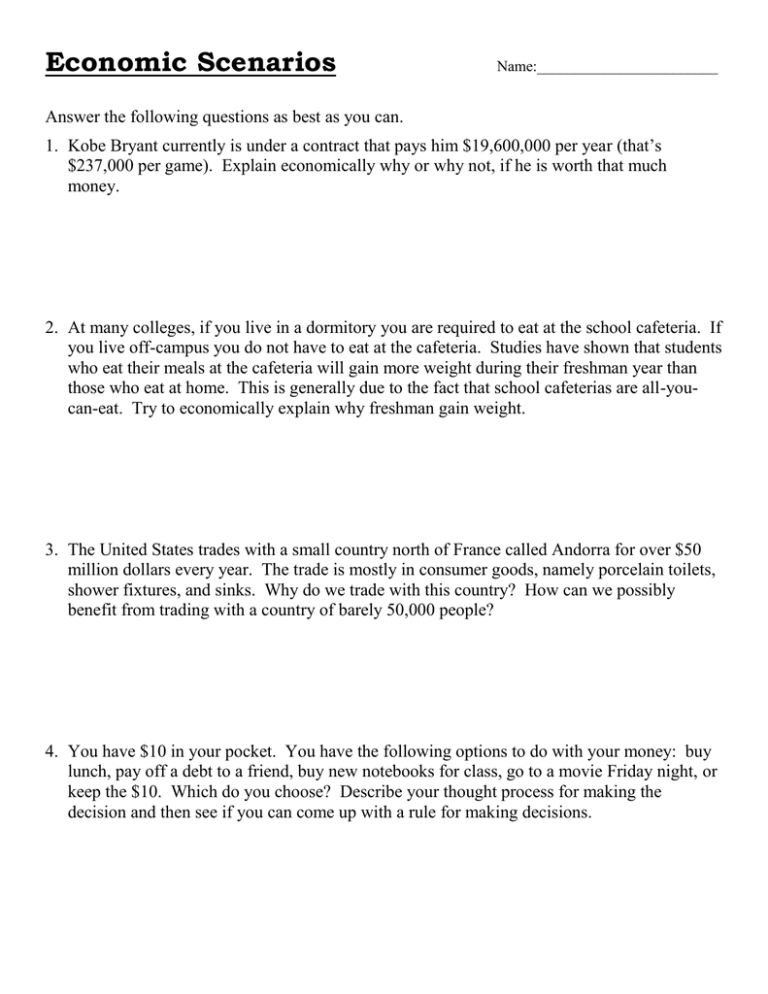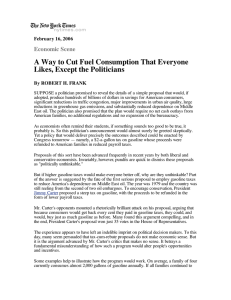Document 14343671
advertisement

Economic Scenarios Name:________________________ Answer the following questions as best as you can. 1. Kobe Bryant currently is under a contract that pays him $19,600,000 per year (that’s $237,000 per game). Explain economically why or why not, if he is worth that much money. 2. At many colleges, if you live in a dormitory you are required to eat at the school cafeteria. If you live off-campus you do not have to eat at the cafeteria. Studies have shown that students who eat their meals at the cafeteria will gain more weight during their freshman year than those who eat at home. This is generally due to the fact that school cafeterias are all-youcan-eat. Try to economically explain why freshman gain weight. 3. The United States trades with a small country north of France called Andorra for over $50 million dollars every year. The trade is mostly in consumer goods, namely porcelain toilets, shower fixtures, and sinks. Why do we trade with this country? How can we possibly benefit from trading with a country of barely 50,000 people? 4. You have $10 in your pocket. You have the following options to do with your money: buy lunch, pay off a debt to a friend, buy new notebooks for class, go to a movie Friday night, or keep the $10. Which do you choose? Describe your thought process for making the decision and then see if you can come up with a rule for making decisions. Basic Economic Principles: Case Studies Honors Economics Name: ______________________ CASE STUDY #1 Economists were surprised to discover that most people, when interviewed immediately after purchasing gasoline, did not have any idea what they paid per gallon. Non-economists use this as evidence against the notion that people are rational. Economists maintain that price (cost) is an important determinant of consumer behavior, yet, apparently people don’t even consider price. How can economists predict consumer behavior if consumers don’t even know what price is? Interestingly, it was discovered that at the end of the month, those gasoline stations that charged the highest prices sold the least gasoline, and those that charged the lowest prices sold the most gasoline. Apparently, although most people didn’t know the price per gallon, nevertheless as a group, consumers bought more of that gasoline that was sold at a cheaper price. Consider this apparent contradiction then answer the following questions: Which consumers are more likely to know the price of gasoline? Why does the average consumer not know the price of the gasoline? Why might some consumers knowingly pay a higher price for gasoline? Can we as future economists believe in the principle of rational behavior or is it disproved in this case? Do you think this case study was done recently? Why or why not? CASE STUDY #2 Over the past 20 years the percentage of women in the labor force has increased dramatically. In recent years divorce rates, and the number of women and children officially classified as living in poverty have increased also. Some people maintain that higher percentages of women in the labor force reflect the fact that “times are tougher and it now takes two people to support a family.” Others maintain that the feminist movement is the main reason for some of these changes. Almost everyone sees higher divorce rates and higher poverty rates for women and children as a serious social problem and increased human misery. Consider, however, that over the past 20 years real (inflation-adjusted) wage rates have increased in the United States, and that therefore the opportunity cost for women staying out of the labor force has risen. How might increased female percentages in the labor force be accounted for by rational family decision-making process? Is it more rational for women to opt for divorce now than it was 20 years ago? If women choose divorce, work, and income that is officially considered to be at poverty levels, are their lives necessarily worse? Economics Terms Name:_________________________ Below are terms important to the study of economics. We will go over them in class this week and have a small quiz next week. Take whatever notes you feel are necessary. Capitalism Command Economy Traditional Economy Mixed Economy 3 Factors of Production Opportunity Cost Scarcity Ceteris Paribus Rational Decisions GDP Per capita GDP Real GDP Consumer Spending Government Spending Investment Spending Imports Exports Balance of Trade Federal Deficit (Surplus) National Debt Consumer Price Index (CPI) Inflation (Deflation) Stagflation Unemployment Rate Recession Depression Strong (weak) dollar APR / APY Federal Reserve System Ben Bernanke and Alan Greenspan









